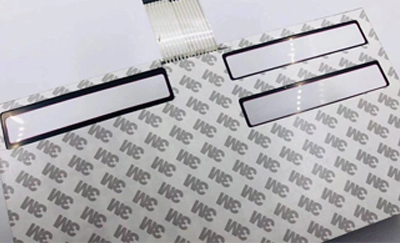
Membrane switches are structurally divided into two categories: tactile and non-tactile. Non-tactile type usually has two types of non-tactile structures: flat type non-tactile type and convex key frame (in some cases convex blind spot). This article focuses on non-tactile membrane switches.
There are two common types of bubbling touch type: the upper circuit and the panel are both bubbling and the panel bubbling. For some ultra-thin structures, the upper circuit is removed, and the upper circuit contacts are directly printed on the panel. The blisters of the membrane switch are formed by heating the mold with hydraulic pressure, so that the key body is slightly bulged, slightly higher than the panel, forming a three-dimensional membrane switch key. The material is made of PET with excellent toughness and heat shrinkage. The bubbles form a resilience, so the touch-sensitive membrane switch of the bubbling bubble has a very good feel and sensitive electrical performance, but be careful not to use it for a long time in a high temperature environment, as high temperature will weaken the feel of the keys.
Bubble-type membrane switches generally use bubbling on both the upper circuit and the panel. When the upper circuit is not bubbling, consider the position of the ventilation groove, and make small holes in the upper circuit for air holes, and if necessary, in the lower circuit. Reasonable isolation points are added to the contacts to avoid the hidden danger of short circuit and connection; if the contacts are directly printed on the panel, it is necessary to consider the deformation of the panel after the panel is aged at high temperature. If the baking time is too long, the deformation will be large. , It will cause great trouble to the assembly and paste of the membrane switch. If the high temperature baking time is too short, the aging time of the contacts on the panel will not be enough, the contacts will be easily worn, and the service life of the product will be shortened.
The shrapnel (dome) tactile membrane switch means that the shrapnel is fixed on the lower circuit to form a pole as the upper circuit. When the shrapnel is pressed, it is connected to the other pole of the lower circuit to form a loop. The keys of the shrapnel tactile membrane switch can be designed to be diversified, making the product more stable and reliable, and at the same time improving the decorative effect of the product to achieve a perfect appearance. The panel can be designed as plane, convex spherical, convex plane, and the shape can be irregular shape such as circle, square, triangle, etc. When the button is designed as a plane or convex button border and blind spot, the surface adhesive layer should be thickened. There is enough space to make the shrapnel travel freely. If the hand feel is not good, a small gasket should be added to the back of the panel keys; the design of the shrapnel fixing layer can be divided into punching holes at the corresponding key positions (the hole diameter should be smaller than the shrapnel). ) or bubbling, the punching design will feel more crisp and the strength is even, and the bubbling design will provide better overall sealing.
The second structure of the shrapnel touch type means that the shrapnel is directly added to the key position of the upper circuit to enhance the feel. When the number of keys is particularly large, the overall shape is small, and there is no space for wiring, it is designed as an upper and lower circuit structure, but this The sensitivity of this structure is slightly weaker, the pressing force should be slightly larger, and the time to release the finger should be slightly longer.